Peter C. Junk (James Cook University)
George Koutsantonis (The University of Western Australia)
This special issue is dedicated to the stellar career of Professor Glen Deacon from Monash University, Australia.
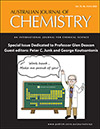
Australian Journal of Chemistry
Volume 75 Numbers 8 & 9 2022
Special IssueSpecial Issue Dedicated to Professor Glen Deacon
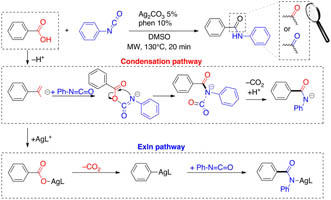
While gas-phase studies suggest that both silver-mediated extrusion-insertion (ExIn) and base-mediated condensation reactions operate for the generation of N-phenyl-benzamide anion from the benzoate anion, the condensation reaction is favoured in the solution phase.

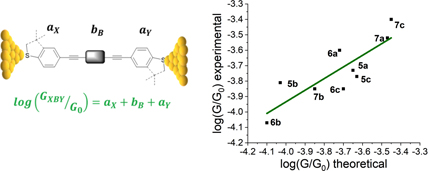
A two-step, one-pot synthesis of oligo(arylene–ethynylene) molecular wires that avoids manipulation of sensitive terminal bis(alkynes) is described. Trends in molecular conductance do not track with the molecular core aromaticity, but correlate with the recently described quantum circuit rules and associated bridge and anchor parameters.
CH21235 Abstract | CH21235 Full Text | CH21235PDF (2.3 MB) | CH21235Supplementary Material (2.1 MB) Open Access Article
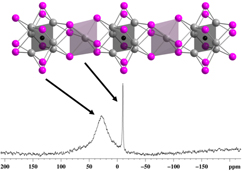
Excision of the carbon-centred Sc cluster {CSc6} from solid {CSc6}I12Sc gave NMR and EPR spectroscopic evidence for a red cluster {CSc6}ImLn (L = solvent ligands) together with isolated and structurally characterised [Sc(L)6]I3 (L = DMA or THF).
 , Svetlana K. Polyakova, Vasily A. Ilichev, Andrey A. Kukinov, Roman V. Rumyantcev, Georgy K. Fukin, Artem N. Yablonskiy and Mikhail N. Bochkarev
, Svetlana K. Polyakova, Vasily A. Ilichev, Andrey A. Kukinov, Roman V. Rumyantcev, Georgy K. Fukin, Artem N. Yablonskiy and Mikhail N. Bochkarev 
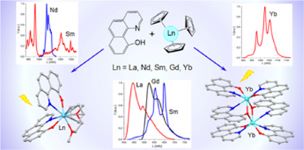
New heteroleptic lanthanide complexes with oxybenzo[h]quinoline ligands were obtained and their photoluminescent (PL) properties were studied. The PL spectrum of the La compound contains phosphorescent bands with a lifetime over 10 ms. The complexes of Nd, Sm and Yb display metal-centered luminescent f–f transitions.
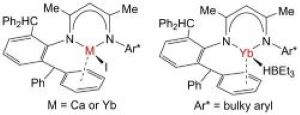
The extremely bulky β-diketiminato calcium(ii) and ytterbium(ii) iodide complexes [(Ar*Nacnac)MI] (M = Ca or Yb) have been prepared. The reduction of [(Ar*Nacnac)CaI] with sodium metal yielded a ligand C–H activated product, while reaction of [(Ar*Nacnac)YbI] with K[HBEt3] gave an ytterbium(ii) borate contact ion pair (e.g. see picture).
CH21283 Abstract | CH21283 Full Text | CH21283PDF (1.1 MB) | CH21283Supplementary Material (166 KB) Open Access Article
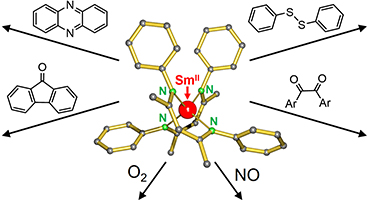
The structure and synthesis of a low-valent β-diketiminate SmII complex are reported and its redox reactivity with various reagents was investigated. With a rich redox reactivity, the SmII complex is an easy-to-prepare, attractive reducing agent that is soluble in apolar organic solvents.

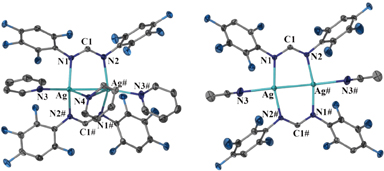
Dinuclear silver formamidinates and polynuclear, mainly trinuclear, silver pyrazolates were successfully synthesized in good yield by treating silver(i) oxide with the corresponding formamidines (FormH) or pyrazoles (pzH) either in pyridine or acetonitrile.
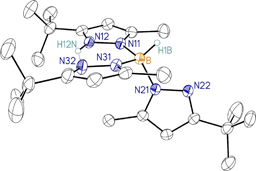
Trofimenko’s original protocol (aqueous KTpR,R′/glacial acetic acid) is a suitable method to obtain the acid form of various scorpionate ligands as long as the pyrazolyl ring 3-substituent provides sufficient steric protection to the acidic N–H proton of H(TpR,R′); structure of H(TptBu,Me)
 , M. A. Kiskin, A. V. Sidoruk, E. A. Varaksina, M. A. Shmelev, N. V. Gogoleva, I. V. Taydakov and I. L. Eremenko
, M. A. Kiskin, A. V. Sidoruk, E. A. Varaksina, M. A. Shmelev, N. V. Gogoleva, I. V. Taydakov and I. L. Eremenko

New complexes of Eu3+ and Tb3+ with pentafluorophenylacetic acid have been studied. During synthesis under hydrothermal conditions, polymer structures are formed, while the introduction of phenanthroline and Cd2+ makes it possible to obtain molecular complexes. A change in the structure leads to significant changes in the luminescent properties.
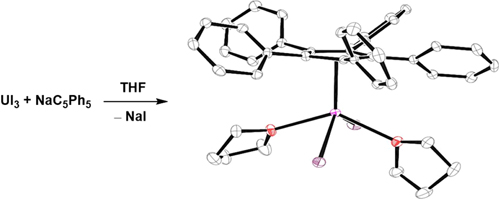
The synthesis of the first C5Ph5 complex of an actinide metal, (η5-C5Ph5)UI2(THF)2, is described. Additionally, X-ray crystal structures of two alkali-metal salts of the [C5Ph5]1− anion are reported.
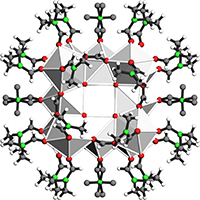
Two dodecanuclear coordination compounds of trivalent rare earth metal cations show short interatomic RE–RE distances due to bridging O atoms from hydroxide and formate anions. Magnetic susceptibility and structural details suggest single molecule magnetic behaviour.

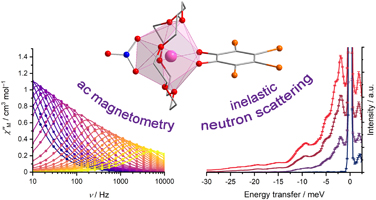
The family of compounds [Ln(18-c-6)(NO3)(Br4Cat)]·X (Ln = La, Tb, Dy; 18-c-6 = 18-crown-6; Br4Cat2− = tetrabromocatecholate; X = MeCN, CH2Cl2, toluene) has been studied by inelastic neutron scattering and magnetometry to elucidate the effects of crystal packing and particle size on the slow magnetic relaxation of the Tb(III) and Dy(III) analogues.
CH21306 Abstract | CH21306 Full Text | CH21306PDF (4.2 MB) | CH21306Supplementary Material (3.1 MB) Open Access Article
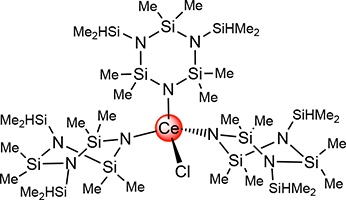
Compound [K(dhts)(thf)]2 bearing the 6-membered 3,5-bis(dimethylsilyl)-2,2,4,4,6,6-hexamethyl-1,3,5,2,4,6-triazatrisilinan-1-ido (dhts) ligand engages in salt metathesis with cerous chloride to afford Ce(dhts)3(thf). Redox treatment of the cerous silylamide with trityl chloride accomplishes Ce(dhts)3Cl (depicted) featuring a rare example of a heteroleptic ceric silylamide complex.

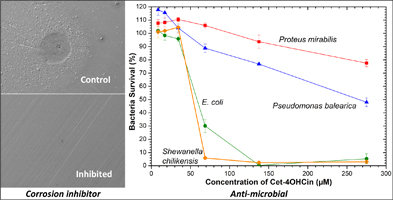
High strength steel shows severe corrosion susceptibility in marine environments, which is exacerbated by bacteria. Here we propose a novel method to minimise these effects by combining a newly synthesised anti-microbial, cetrimonium 4-hydroxycinnamate (Cet-4OHCin), with the corrosion inhibiting lanthanum 4-hydroxycinnamate. Furthermore, cytotoxicity testing demonstrated Cet-4OHCin to be as safe as the chemically related cosmetic additive cetrimonium bromide.
CH21266 Abstract | CH21266 Full Text | CH21266PDF (2.3 MB) | CH21266Supplementary Material (1.6 MB) Open Access Article
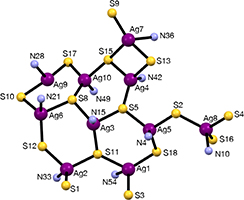
A complex that consists of twenty silver(I) ions supported by eighteen bis(thiosemicarbazonato) ligands is reported here. The cluster of silver(I) ions involves several close Ag⋯Ag contacts suggestive of argentophilic interactions and the bis(thiosemicarbazonato) ligands are present in three different conformations.
CH21335 Abstract | CH21335 Full Text | CH21335PDF (2.5 MB) | CH21335Supplementary Material (440 KB) Open Access Article
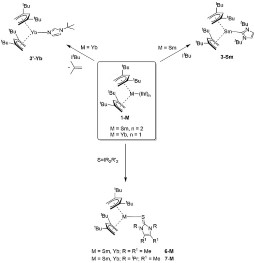
Reaction of the open samarocene [(η5-pdl′)2Sm(thf)2] (1-Sm) and open ytterbocene [(η5-pdl′)2Yb(thf)] (1-Yb) towards N-heterocyclic carbenes (NHC) and imidazoline-2-thione has been evaluated. While adduct formation occurs readily for 1-Sm, unexpected side reactions have been encountered for 1-Yb.
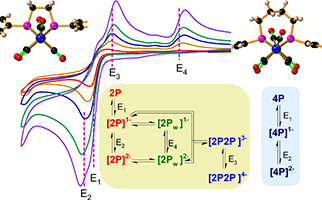
Integration of IR spectroelectrochemical and electrochemical simulation of the series of phosphido-bridged diiron hexacarbonyl complexes, Fe2(µ2-PPh2(CH2)xPPh2)(CO)6, x = 2 (2P) and (4P) and previously reported x = 3 (3P) and bis-diphenylphosphido (DP) analogues have allowed delineation of the impact of constraints on the 2Fe2P core geometry on the reduction chemistry. The sensitivity of the reduction chemistry of the bridged diiron compounds underpins their utility as catalytic proton reduction catalysts and the systematic trends delineated in this investigation provide the framework for charting the path of their redox-coupled chemical reactions.
CH21309 Abstract | CH21309 Full Text | CH21309PDF (3.6 MB) | CH21309Supplementary Material (1.7 MB) Open Access Article
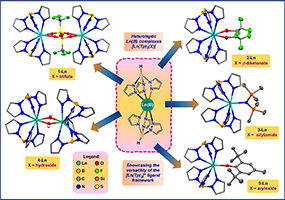
Scorpionate nitrogen-donor trispyrazolylborate (Tp) ligands are well-known in transition metal chemistry. However, in lanthanide chemistry the literature is dominated by substituted analogues of Tp and the chemistry of the unsubstituted Tp ligand has remained largely unexplored. We discovered as part of a different research project that the [Ln(Tp)2]+ unit is both highly reactive and capable of supporting a variety of co-ligands. This paper builds on this discovery to present rational synthetic routes to a series of heteroleptic lanthanide complexes, [Ln(Tp)2(X)].


Reactions of aluminum and indium halides including chlorides, bromides and iodides with pyrazine (pyz) lead to one-dimensional coordination polymers and molecular complexes with coordination numbers ranging from four to six. The degree of linkage of pyrazine discriminates between polymers and complexes.
 , Peter Evans, Hongrui Zhang, Gemma K. Gransbury, George F. S. Whitehead and David P. Mills
, Peter Evans, Hongrui Zhang, Gemma K. Gransbury, George F. S. Whitehead and David P. Mills 
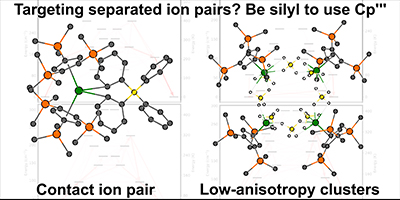
We report the synthesis and characterisation of a series of heteroleptic yttrium and dysprosium 1,2,4-tris(trimethylsilyl)cyclopentadienyl complexes containing halide, borohydride or allyl co-ligands. Attempts to abstract co-ligands and install weakly coordination anions to generate lanthanoid metallocenium cations were unsuccessful, which we attribute to side reactions with 1,2,4-tris(trimethylsilyl)cyclopentadienyl rings.

This study investigates the content, scope and approaches to learning in advanced (third-year) inorganic chemistry laboratory curricula at Australian universities. Staff at 19 of the 23 Australian institutions that offer undergraduate degrees with a Chemistry major participated in this study.
CH21334 Abstract | CH21334 Full Text | CH21334PDF (866 KB) | CH21334Supplementary Material (240 KB) Open Access Article
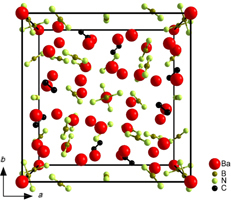
The new compound Ba21[BN2]11[C2]4 was obtained by a high-temperature solid-state reaction crystallising in a complex novel crystal structure. The shiny black crystals are sensitive to oxygen, water and electromagnetic radiation. Ba21[BN2]11[C2]4 is a subvalent compound with one excess electron per formula unit, similar to binary barium subnitrides. In the extended unit cell of Ba21[BN2]11[C2]4, the [BN2]3− and [C2]2− anions provide coordination numbers of 7 to 9 for the Ba2+ cations with their terminal atoms by end-on and side-on coordination.
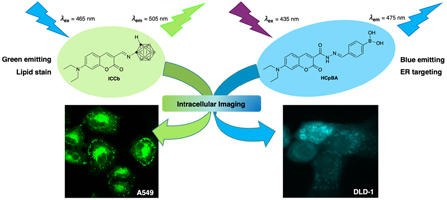
Novel boron-containing hydrazone and imino-coumarin derivatives were prepared and their intracellular localisations were evaluated by means of confocal microscopy. Carborane conjugates (HCCb and ICCb) were found to be effective lipid droplet stains, and the boronic acid probes (HCoBA, HCmBA and HCpBA) targeted the endoplasmic reticulum (ER).
CH21320 Abstract | CH21320 Full Text | CH21320PDF (1.6 MB) | CH21320Supplementary Material (1.5 MB) Open Access Article

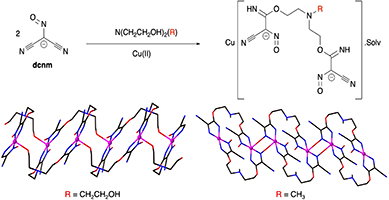
The transition metal-promoted in situ nucleophilic addition of triethanolamine (teaH3) and N-methyldiethanolamine (mdeaH2) to the dicyanonitrosomethanide (dcnm) anion results in the formation of 1D coordination polymers containing the new ligands. These are the first reported addition reactions between dcnm anions and more than one alcohol moiety on a single ligand.
CH21323 Abstract | CH21323 Full Text | CH21323PDF (1.7 MB) Open Access Article
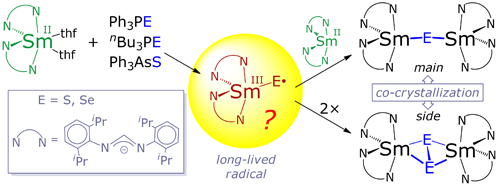
Samarium(ii) formamidinates are promising candidates for studying reductive transformations. As opposed to samarocenes(ii), they provide a flexible coordination sphere that can fit the steric demands of a reduced substrate. Reduction of phosphine(arsine) chalcogenides has resulted in mono- and dichalcogenide complexes capable of co-crystallization. Long-lived S-centered radicals are expected to be the key reactive species in these processes.


From the redox-transmetallation protolysis (RTP) reaction of europium metal, Hg(C6F5)2 and pentaphenylcyclopentadiene, or 1,2,3,4,5-pentaphenylcyclopentadiene-1,3-dienol (C5Ph5OH), we isolated and crystallographically characterised the first divalent europium fluoride half-sandwich complex [Eu(C5Ph5)(μ-F)(thf)2]2 and a new divalent Eu alkoxide complex [Eu(OC5Ph5*)2(thf)4] respectively, the latter having an intriguing phenyl group migration in the cyclopentadiene ligand.
CH21324 Abstract | CH21324 Full Text | CH21324PDF (2.1 MB) | CH21324Supplementary Material (1.2 MB) Open Access Article
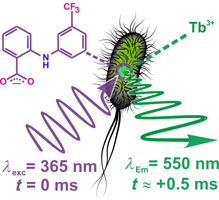
Bacteria can be stained with Tb salts of flufenamic acid to yield narrow-line green-emitting microbes that can optimally be excited at 365 nm, i.e. with high-power UV-light-emitting diodes (LEDs). The bacteria furthermore exhibit advantageously long lifetimes in the millisecond range – good conditions for e.g. luminescence microscopy and time-gated analyses.
CH21315 Abstract | CH21315 Full Text | CH21315PDF (1.5 MB) | CH21315Supplementary Material (563 KB) Open Access Article
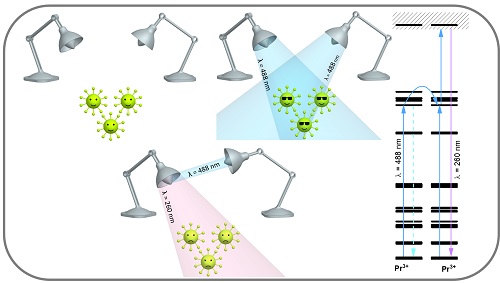
Up-conversion particles convert visible light into UV-C radiation upon illumination. The obtained UV spectrum is capable of inactivating exposed microorganisms. If particles are in the shade, UV radiation is no longer generated, which means that the user is not exposed to harmful UV radiation.
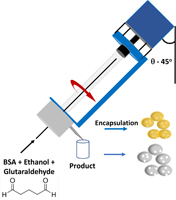
The continuous flow synthesis of bovine serum albumin nanospheres (BNPs) and their composite with curcumin is vortex fluidic mediated. BNPs of ca. 531 nm in diameter are formed at 5k rpm in a single step process, while BNPs of ca. 615 nm in diameter are formed in the presence of curcumin.
CH21345 Abstract | CH21345 Full Text | CH21345PDF (6.3 MB) | CH21345Supplementary Material (453 KB) Open Access Article

[I(py)2]I3·2I2 selectively iodinates electron-rich phenol groups of calix[4]arenes. Less electron-rich aryl rings remain unaffected. Self-inclusion of iodinated calix[4]arenes occurs in the solid state.